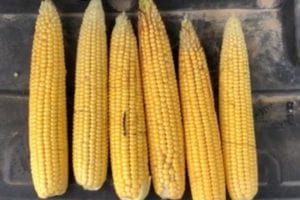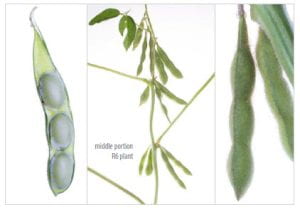 According to the latest Ohio Crop Weather Report 90% of the Ohio corn crop is in the dough stage, 3 percentage points ahead of the 5-year average. 40% of the crop is in the dent stage 10% below the 5 year average.
According to the latest Ohio Crop Weather Report 90% of the Ohio corn crop is in the dough stage, 3 percentage points ahead of the 5-year average. 40% of the crop is in the dent stage 10% below the 5 year average.
This time of year many of us begin to think about our potential corn yield. The most popular yield estimator is the THE YIELD COMPONENT METHOD. This procedure was developed by the Agricultural Engineering Department at the University of Illinois. The yield component method involves use of a numerical constant for kernel weight which is figured into an equation in order to calculate grain yield. This numerical constant is sometimes referred to as a “fudge‑factor” since it is based on a predetermined average kernel weight. Since weight per kernel will vary depending on hybrid and environment, the yield component method should be used only to estimate relative grain yields, i.e. “ballpark” grain yields. When below normal rainfall occurs during grain fill (resulting in low kernel weights), the yield component method will OVERESTIMATE yields. In a year with good grain fill conditions (resulting in high kernel weights) the method will underestimate grain yields.
In the past, the YIELD COMPONENT METHOD equation used a “fudge factor” of 90 (as the average value for kernel weight, expressed as 90,000 kernels per 56 lb bushel), but kernel size has increased as hybrids have improved over the years. Assuming no stress during grain fill, a “fudge factor” of 80 to 85 (85,000 kernels per 56 lb bushel) is a more realistic value to use in the yield estimation equation today.
Step 1. Count the number of harvestable ears in a length of row equivalent to 1/1000th acre. For 30‑inch rows, this would be 17 ft. 5 in.
Step 2. On every fifth ear, count the number of kernel rows per ear and determine the average.
Step 3. On each of these ears count the number of kernels per row and determine the average. (Do not count kernels on either the butt or tip of the ear that are less than half the size of normal size kernels.)
Step 4. Yield (bushels per acre) equals (ear #) x (avg. row #) x (avg. kernel #) divided by 85.
Step 5. Repeat the procedure for at least four additional sites across the field. Keep in mind that uniformity of plant development affects the accuracy of the estimation technique.
The more variable crop development is across a field, the greater the number of samples that should be taken to estimate yield for the field.
Example: You are evaluating a field with 30‑inch rows. You counted 32 ears (per 17′ 5″ = row section). Sampling every fifth ear resulted in an average row number of 16 and an average number of kernels per row of 33. The estimated yield for that site in the field would be (32 x 16 x 33) divided by 85, which equals 199 bu/acre.



 Most of the corn that I have seen this week is in either the
Most of the corn that I have seen this week is in either the 
 Most of the corn that I have seen this week is in the
Most of the corn that I have seen this week is in the 

 Seventy-nine percent of corn was in or past dough, and 30 percent of Ohio corn was in or past dent. Ninety percent of soybeans were setting pods. Corn and soybean condition were 79 and 76 percent good to excellent, respectively. Second cuttings of other hay were 88 percent complete. Third cuttings of alfalfa hay and other dry hay were 69 and 44 percent complete, respectively. Pasture and range condition was rated 66 percent good to excellent, up from the previous week.
Seventy-nine percent of corn was in or past dough, and 30 percent of Ohio corn was in or past dent. Ninety percent of soybeans were setting pods. Corn and soybean condition were 79 and 76 percent good to excellent, respectively. Second cuttings of other hay were 88 percent complete. Third cuttings of alfalfa hay and other dry hay were 69 and 44 percent complete, respectively. Pasture and range condition was rated 66 percent good to excellent, up from the previous week.









 Disease pressure throughout the county continues to be very low. At this stage of growth, with little to no disease pressure, and new crop corn under $5 can we justify at least $25 per acre for a fungicide application?
Disease pressure throughout the county continues to be very low. At this stage of growth, with little to no disease pressure, and new crop corn under $5 can we justify at least $25 per acre for a fungicide application?

 It’s that time of year when weeds are beginning to show their ugly heads above the soybean canopy in many fields. During your scouting, if you find Palmer Amaranth or Waterhemp you should do whatever you can to prevent these devastating weeds from going to seed, including removing the entire plant from the field.
It’s that time of year when weeds are beginning to show their ugly heads above the soybean canopy in many fields. During your scouting, if you find Palmer Amaranth or Waterhemp you should do whatever you can to prevent these devastating weeds from going to seed, including removing the entire plant from the field.




 Last week, warm and dry conditions dominated across the State, according to Ben Torrance, State Statistician, USDA NASS, Ohio Field Office. The most recent U.S. Drought Monitor report showed 18.5 percent of the State as abnormally dry or worse, a decrease from the previous week. Conditions matching the moderate drought rating were observed in 1.7 percent of the State. Topsoil moisture conditions were rated 2 percent very short, 23 short, 71 percent adequate, and 4 percent surplus. Statewide, the average temperature for the week ending on August 6 was 71.3 degrees, 0.7 degrees below normal. Weather stations recorded an average of 0.17 inches of precipitation, 0.65 inches below average. There were 6.1 days suitable for fieldwork during the week ending August 6.
Last week, warm and dry conditions dominated across the State, according to Ben Torrance, State Statistician, USDA NASS, Ohio Field Office. The most recent U.S. Drought Monitor report showed 18.5 percent of the State as abnormally dry or worse, a decrease from the previous week. Conditions matching the moderate drought rating were observed in 1.7 percent of the State. Topsoil moisture conditions were rated 2 percent very short, 23 short, 71 percent adequate, and 4 percent surplus. Statewide, the average temperature for the week ending on August 6 was 71.3 degrees, 0.7 degrees below normal. Weather stations recorded an average of 0.17 inches of precipitation, 0.65 inches below average. There were 6.1 days suitable for fieldwork during the week ending August 6.
 R1 – Silking.
R1 – Silking. R3 Beginning Pod
R3 Beginning Pod


 Corn growth varies greatly throughout the county, but, more fields are beginning to tassel. As corn begins to tassel, nutrient (K > N > P) and water (0.30 inch per day) demands for the crop are close to maximum. Heat and drought will affect potential number of kernels. Scout for insects (e.g., corn leaf aphid, western bean cutworm, corn earworm, fall armyworm) and diseases (e.g., gray leaf spot, southern rust, northern leaf
Corn growth varies greatly throughout the county, but, more fields are beginning to tassel. As corn begins to tassel, nutrient (K > N > P) and water (0.30 inch per day) demands for the crop are close to maximum. Heat and drought will affect potential number of kernels. Scout for insects (e.g., corn leaf aphid, western bean cutworm, corn earworm, fall armyworm) and diseases (e.g., gray leaf spot, southern rust, northern leaf VT (Tasseling) – Stage VT occurs two to three days before silking, when the last branch of the tassel is completely visible but silks have not emerged yet from the ear shoot. The plant has reached full height and the pollen shed begins. The time between VT and R1 can vary with different hybrids and due to environmental conditions.
VT (Tasseling) – Stage VT occurs two to three days before silking, when the last branch of the tassel is completely visible but silks have not emerged yet from the ear shoot. The plant has reached full height and the pollen shed begins. The time between VT and R1 can vary with different hybrids and due to environmental conditions. Postemergence herbicide applications – Don’t forget the preharvest intervals (PHI) for grazing or harvest.
Postemergence herbicide applications – Don’t forget the preharvest intervals (PHI) for grazing or harvest. 
